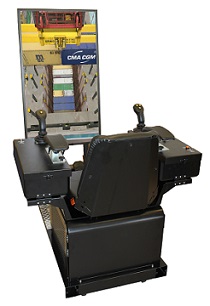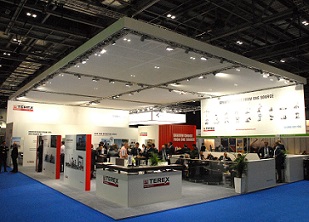Visitors
had the opportunity to gain insights into the current innovation activities of TPS around the globe. New virtual reality technology will showcase the Terex® Liftace™ 5-31 reach stacker and the Terex® Stackace™ E 6-8 empty container handler.
The Liftace reach stacker is the first member of the TPS new-generation lift truck family and has generated strong demand both in Europe and North America from the start. Klaus Peter Hoffmann, Vice President & Managing Director TPS: “Both the Liftace reach stacker and the Stackace empty container handler are cost-effective, serviceable and ergonomic machines. The new trucks offer low fuel consumption and wear in addition to particularly easy access to maintenance points to facilitate servicing. They are also designed to be especially ergonomic with a user-friendly cab. The two aces combine the expertise and strengths of the two Terex legacy brands, PPM and Fantuzzi, with many innovative features.”
More innovative technology from TPS will help Port Newark Container Terminal LLC (PNCT), Newark, New Jersey, to pioneer eco-friendly container handling in the US. From July, PNCT will operate 20 new Terex® straddle carriers featuring the latest diesel-electric drives. Hoffmann: “The EPA Tier 4 final (EU Stage IV) compliant machines will contribute to a significant reduction in fuel consumption and pollutant emissions. We are proud that our state-of-the art technology will help another customer to reach their environmental target. Moreover, the use of a fleet of battery-driven Terex® Gottwald automated guided vehicles (battery AGVs) helped Long Beach Container Terminal (LBCT) to win the prestigious California Air Quality Award in May.”
Battery AGVs also play a key role in the TPS terminal automation strategy. The unmanned, software-controlled machines provide a horizontal container transport solution with low noise and zero emissions to help clients become leaders in terminal automation. According to Hoffmann, “Worldwide, TPS equipment is working in seven automated container terminals – more than any other manufacturer. Maasvlakte, only 50 km from the exhibition venue in Rotterdam, has been one of our lighthouse projects in automation since 1992, with a total of many hundreds AGVs currently in use.” In general, automation is a buzzword in the market place, continues Hoffmann: “Around the globe, the importance of automation is rising. As the manufacturer with the most comprehensive port-related portfolio, TPS also provides clients access to holistic solutions including consulting, planning and management software.”




